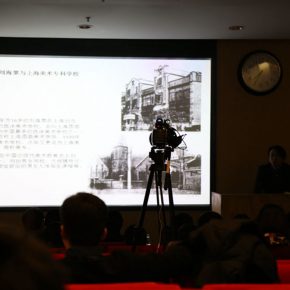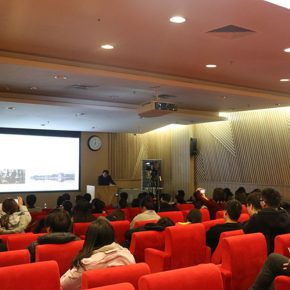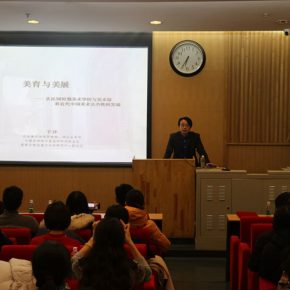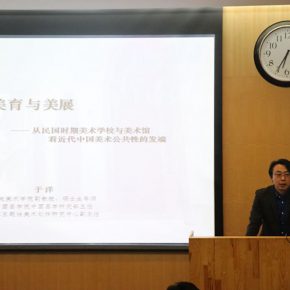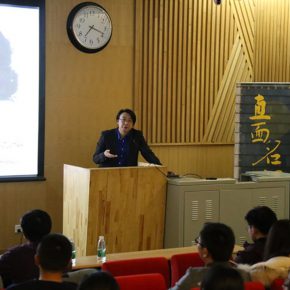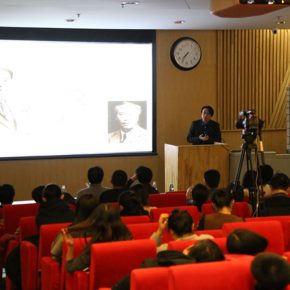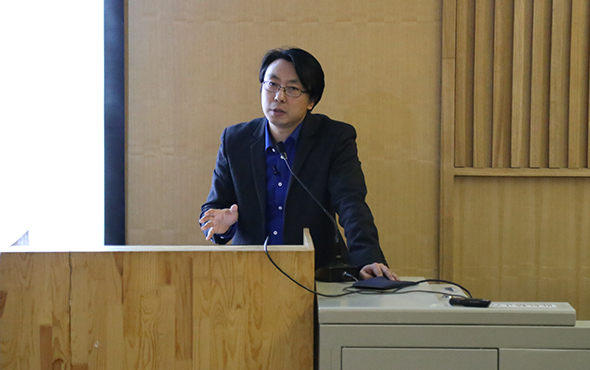
On December 6, 2016, hosted by the Student Union at CAFA, undertaken by the Department of Learning and Practice at the Student Union, CAFA, the 11th “Face Master” series of lectures was held at the red chair lecture hall, building 7. In this lecture, we invited Associate Professor Yu Yang, Master Instructor and Director of the Institute of Chinese Painting at the School of Chinese Painting, Deputy Director of the National Thematic Art Creation Research Center. In the lecture entitled “Aesthetic Education and Art Exhibition – Seeing the Beginning of the Publicity of Contemporary Chinese Fine Arts from the School of Fine Arts and Art Museums in the Period of the Republic of China”, Prof. Yu Yang took us back to the developmental history of modern Chinese Academy of Fine Arts.
At the beginning of the lecture, Yu Yang first proposed that “aesthetic education” and “art exhibition” were two words which were very frequently used, and the two words have always been very closely related. This comes to our field of vision with a modern Chinese context. It is certain that both “aesthetic education” and “art exhibition” represent the new “publicity” of Chinese art. Speaking specifically, we can learn from the huge intersection between both which is also the problem of “publicity of aesthetic culture”: In fact, when we look back at the history of art education and creation of the 20th century, we can summarize it as the history of Chinese art exhibitions, in other words, we can start from several important large-scale art exhibitions of the last century to develop a new interpretation of modern Chinese art history.
In addition, some people say that “it is the era of the art museum”. Yu Yang explained that under the influence of the culture of the art museum, if we take the exhibition as a starting point, we can see that Chinese art has experienced changes in “sociology” and “finance and economics” during their history, bringing people a new round of “change of museology”. Having experienced a few changes, Chinese artists have also carried out several changes in their values. Speaking from a certain perspective, the current artists need to have a sufficient “sociological” consideration: whether they have thought of the presentation of the works when they are being created? Whether they “create depending on actual circumstances”, based on the exhibition space to create works? The discussion of such issues is also the reason for Yu Yang to select the title of the lecture.
Combined with his own research and teaching experience, for each case study, Yu Yang put forward his own academic ideal “Seeing both the trees and the forest”, that is using a small entry point to reflect the background of social development, while using a social background to reflect specific problems one after another in the individual study. And he took the case of Dong Qichang as an example to support it. Dong Qichang put forward “if ropes are untied, we will see the fish scales through the net” in his painting theory of “Hua Zhi (Painting Purpose)”, where “the fish scales come through the net” is the Zen terminology, meaning the use of a vivid metaphor to show successful artists and researchers should both conform with tradition and keep a certain distance from tradition, which is the ideal state when we try to grasp art.
At the beginning of the development of the “aesthetic education” and “art exhibition” in China, Cai Yuanpei who was the leader of the modern art educators, did not only put forward the idea of “making aesthetic education replace religion”, but also advocated civic education, worldly education and aesthetic education, and wrote an article entitled “Culture Movement Can’t Forget Aesthetic Education” to state that it should have lectures and research institutes on literature, aesthetics, and art history in universities. Cai was a man of position, after he directly guided and supported Xu Beihong, Liu Haisu, Lin Fengmian and others, the Chinese art education began a period of considerable progress: many art schools have been established, different exhibitions were unfolded time and time again, the establishment of an art museum was more significant. These different events provided a powerful stimulus for the development of Chinese art. When we observe this period of history, we can easily find that it is the process of artistic publicity that runs through modern Chinese art education and exhibition history.
During the two-hour lecture, Yu Yang led us to clearly understand the history of modern Chinese art education and exhibition by taking the main characters, events (exhibitions) in this history as the main clue. In short, Yu Yang’s wonderful lecture carries on the historical context of the academy, which is indeed very important for students.
Text and photo by the Department of Learning and Practice at the Student Union, CAFA
Translated by Chen Peihua and edited by Sue/CAFA ART INFO


